Are you ready to transform your hairstyle with stunning box braids, but you find yourself torn between the choices of knotless or knotted? Fret not, as we’ve got your back! This article will be your guiding light in making the decision that suits you best.
Knotless box braids, a modern sensation, have surged in popularity recently. This innovative technique starts the braid with your natural hair and gradually integrates extensions, resulting in a seamless, lightweight look with reduced tension on your scalp.
In contrast, knotted box braids offer a timeless and bold style by securing synthetic hair with knots at the roots, providing a sturdy foundation for various hairstyles and maintenance routines.
The choice ultimately rests on your personal preferences, lifestyle, and desired appearance.
If you lean towards a sleek, natural look with minimal scalp tension, knotless box braids may be your ideal choice.
But if you’re aiming for a traditional, versatile style, knotted box braids could be the way to go.
Let’s delve deeper into these two captivating box braid styles to help you find the one that’ll make you feel fabulous and fierce!
The Evolution Of Box Braids
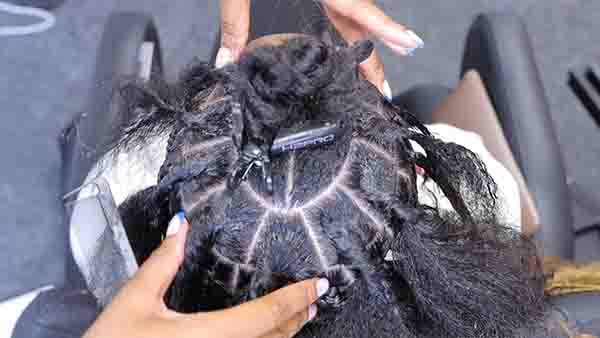
Box braids have a rich history and cultural significance, originating from Africa centuries ago.
These intricate braiding techniques have stood the test of time, evolving to suit different preferences and trends.
Knotless box braids have gained popularity due to their natural appearance and decreased tension on the scalp.
On the other hand, traditional knotted box braids offer a classic and enduring style. People are embracing box braids for their versatility, allowing for various lengths, colors, and patterns. This has led to a surge in their popularity across cultures and communities.
From celebrities to everyday individuals, box braids have become a fashion statement, symbolizing beauty, identity, and self-expression.
Whether you choose knotless or knotted box braids, the artistry and cultural significance behind these hairstyles are truly timeless.
Understanding Knotless Box Braids
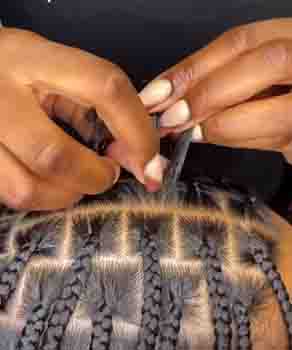
Knotless box braids are a popular and modern twist on traditional braids. Unlike their knotted counterparts, knotless box braids do not have a bulky knot at the base. This makes them more lightweight and comfortable to wear.
One of the benefits of knotless box braids is that they put less tension on the scalp, reducing the risk of hair breakage and damage.
Achieving knotless box braids involves a step-by-step process that begins with preparing the hair by washing and conditioning.
The hair is then sectioned and braided using a feed-in technique, where small amounts of hair are added as the braid progresses.
Finally, the braids are installed and finished with styling touches like beads or accessories. Knotless box braids offer a stylish and versatile protective hairstyle option for anyone looking to switch up their look.
Exploring Knotted Box Braids
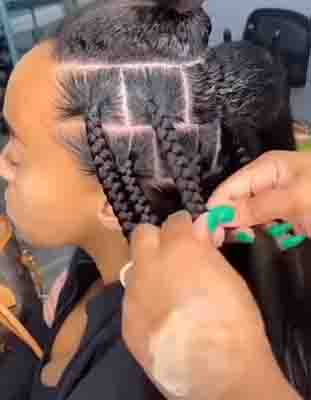
Knotted box braids are a popular hairstyle characterized by small, tightly twisted sections of hair that are secured with knots instead of traditional braids.
These braids provide a distinct look and offer several advantages.
One advantage is that knotted box braids tend to be longer-lasting compared to their knotless counterparts.
Additionally, the knots in knotted box braids add texture and depth to the hairstyle.
However, there are some limitations to consider. Installing knotted box braids requires more time and effort, as each section needs to be carefully knotted.
Moreover, the knots can be a bit uncomfortable and may cause tension on the scalp.
To create knotted box braids, start by preparing the hair, sectioning it, and using proper braiding techniques. Then, go through the installation process, carefully knotting each section, and finalize the braids. With a bit of practice and patience, you can achieve stunning knotted box braids.
Knotless VS Knotted Box Braids: Comparing Both Braids

Comparing knotless and knotted box braids reveals important differences in appearance and style.
Knotless braids offer a more natural look, while knotted ones have a distinct, tightly braided appearance. In terms of durability and longevity, knotless braids tend to last longer due to their seamless and less tension-prone technique.
However, both styles require regular maintenance and care routines. Knotless braids may need more frequent touch-ups to maintain their seamless look, while knotted ones may require re-tightening to prevent unraveling. Regardless of which technique you choose, proper care, such as moisturizing and protecting the braids while sleeping or swimming, is essential to prolong the lifespan of your braids.
Understanding the differences and considering your personal preferences will help you choose the best braiding technique for your desired style and maintenance routine.
Pros and cons of knotless box braids
Knotless box braids come with their own set of advantages and disadvantages. Let’s take a look at the pros and cons:
Pros:
- Reduced tension: One of the biggest benefits of knotless box braids is the reduced tension on your scalp. Since there are no knots at the root, there is minimal pulling or tugging, resulting in less discomfort and potential damage to your hair.
- Natural appearance: Knotless box braids blend seamlessly with your natural hair, giving you a more natural and realistic look. The extensions are added gradually, creating a smooth transition from your own hair to the braids.
- Lightweight: Compared to knotted box braids, knotless braids are much lighter. The absence of knots makes them feel more comfortable and less burdensome on your head.
Cons:
- Longer installation time: Due to the time-consuming nature of knotless box braids, the installation process can take longer compared to knotted box braids. This is because each braid is meticulously created by adding extensions to your natural hair, resulting in a longer sitting time at the salon.
- Higher cost: Knotless box braids require more extensions since they start with your natural hair. As a result, they can be more expensive compared to knotted box braids, which only require extensions from the very beginning.
- Limited styling options: Knotless box braids are more delicate and can be prone to unraveling if not properly maintained. This means that you may have to limit certain hairstyles that put excessive tension on the braids.
Pros and cons of knotted box braids
Now, let’s explore the pros and cons of knotted box braids:
Pros:
- Versatility: Knotted box braids offer more versatility when it comes to styling options. The knots at the root provide a strong foundation that can withstand various hairstyles and maintenance routines.
- Longevity: Knotted box braids tend to last longer compared to knotless box braids. The knots at the root create a more secure hold, preventing the braids from unraveling easily.
- Cost-effective: Knotted box braids require fewer extensions since they start with the synthetic hair, making them a more cost-effective option.
Cons:
- Heavier: Knotted box braids are generally heavier compared to knotless box braids due to the knots at the root. This can cause more tension and discomfort on your scalp, especially if you have a sensitive scalp.
- Less natural appearance: The knots in knotted box braids are more visible, which can give a less natural look compared to knotless box braids. If you prefer a more seamless and subtle look, knotted box braids may not be the best option for you.
- Potential damage: The knots in knotted box braids have the potential to cause damage to your natural hair if not installed and maintained properly. It’s important to ensure that the knots are not too tight and to take good care of your braids to prevent breakage.
Factors to consider when choosing between knotless and knotted box braids
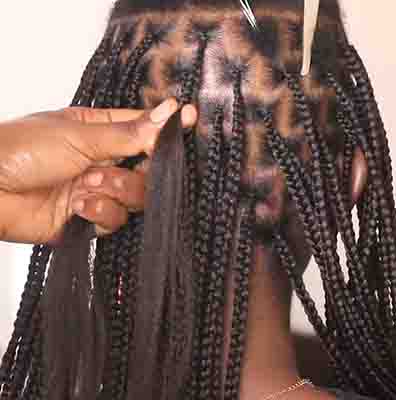
Now that you have an understanding of the differences and pros and cons of knotless and knotted box braids, let’s dive into the factors you should consider when choosing the perfect style for you:
- Hair type and texture: Consider your hair type and texture when deciding between knotless and knotted box braids. If you have fine or delicate hair, knotless box braids may be a better option as they cause less tension and are lighter. If you have thicker or coarser hair, knotted box braids can provide a stronger foundation and longevity.
- Desired look: Think about the look you want to achieve. If you prefer a more natural and seamless appearance, knotless box braids are the way to go. If you want a bold and defined style, knotted box braids will give you the desired effect.
- Lifestyle and activities: Consider your lifestyle and activities when choosing between the two styles. If you lead an active lifestyle or participate in sports or activities that may put stress on your hair, knotted box braids may be more suitable as they provide a stronger hold. If you prefer a more lightweight and comfortable option, knotless box braids are the better choice.
Step-by-step guide to getting knotless box braids
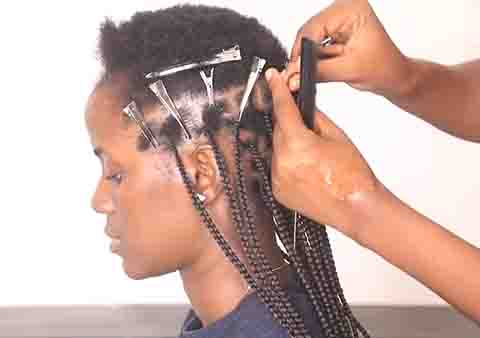
Ready to rock some knotless box braids? Follow this step-by-step guide to achieve the perfect look:
- Start with clean and detangled hair: Before getting knotless box braids, make sure your hair is clean and free of any tangles. This will make the installation process smoother and easier.
- Section your hair: Divide your hair into small sections using a rat-tail comb. The size of the sections will depend on your desired braid size.
- Add extensions: Take a small section of your natural hair and attach the extension hair to it. Begin braiding the hair, gradually adding more extensions as you go. Continue braiding until you reach the desired length.
- Repeat the process: Repeat the previous step until all sections of your hair are braided with extensions.
- Seal the ends: To secure the ends of the braids, dip them in hot water or use a lighter to seal them. Be careful not to burn yourself or damage the braids.
- Style as desired: Once your knotless box braids are complete, you can style them in various ways, such as updos, ponytails, or buns.
Step-by-step guide to getting knotted box braids
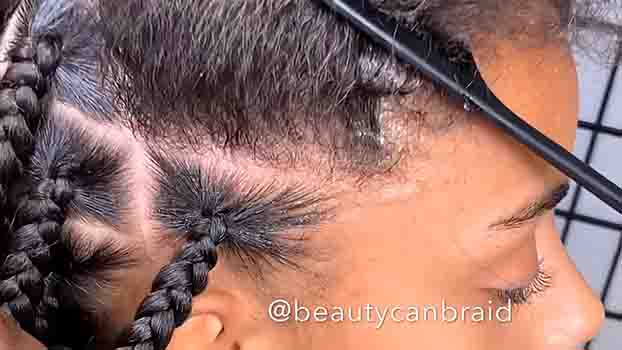
If you’re leaning towards knotted box braids, here’s a step-by-step guide to achieving the look:
- Wash and condition your hair: Start by washing and conditioning your hair to ensure it’s clean and well-moisturized.
- Section your hair: Divide your hair into small sections using a rat-tail comb. The size of the sections will depend on your desired braid size.
- Attach the synthetic hair: Take a small section of your natural hair and attach the synthetic hair to it using a knot. Start braiding the hair, making sure to tightly secure the knot at the root. Continue braiding until you reach the desired length.
- Repeat the process: Repeat the previous step until all sections of your hair are braided with the synthetic hair.
- Seal the ends: To secure the ends of the braids, dip them in hot water or use a lighter to seal them. Be cautious during this step to avoid any accidents.
- Style as desired: Once your knotted box braids are complete, you can style them in various ways, such as braided updos, half-up half-down styles, or even accessorize them with beads or cuffs.
Maintenance and care tips for knotless box braids

To keep your knotless box braids looking fresh and fabulous, here are some maintenance and care tips:
- Moisturize your scalp: Use a lightweight oil or moisturizing spray to keep your scalp hydrated and prevent dryness.
- Wash with care: When washing your hair, be gentle and avoid excessive rubbing or pulling on the braids. Use a sulfate-free shampoo and conditioner to maintain the integrity of your braids.
- Protect your hair at night: Cover your braids with a satin or silk bonnet or use a satin pillowcase to prevent friction and maintain the longevity of your braids.
- Avoid excessive heat: Minimize the use of heat styling tools on your braids to prevent damage. If you do use heat, use a heat protectant spray and keep the temperature low.
- Refresh your edges: As your natural hair grows, your edges may start to show. Use edge control or gel to smooth down any flyaways and maintain a neat appearance.
Maintenance and care tips for knotted box braids

To keep your knotted box braids looking their best, follow these maintenance and care tips:
- Keep your scalp clean: Regularly cleanse your scalp with a gentle shampoo to remove any product buildup or dirt. Be gentle when washing to avoid disturbing the knots.
- Moisturize your scalp: Apply a lightweight oil or moisturizer to your scalp to keep it hydrated and prevent dryness.
- Avoid excessive manipulation: Minimize pulling or tugging on the braids to prevent the knots from unraveling. Be gentle when styling or tying up your hair.
- Protect your hair at night: Cover your braids with a satin or silk bonnet or use a satin pillowcase to reduce friction and maintain the integrity of the knots.
- Regular touch-ups: As your natural hair grows, you may need to visit the salon for touch-ups to re-knot any loose or unraveling braids.
- Be mindful of hairstyles: Avoid hairstyles that put excessive tension on the knots, as this can lead to breakage or damage. Opt for loose or low manipulation styles to keep your braids intact.
FAQ
Knotless braids often last longer because they reduce tension and stress on the scalp, potentially leading to less damage compared to traditional knot braids.
It’s generally recommended to keep knotless braids in for 2 to 3 months (8-10 weeks) to prevent tangling, matting, and hair damage.
Knotless braids can be faster to install than box braids due to their technique. However, the duration depends on braid size, hair type, and stylist’s speed.
Knotless braids can last around 6 to 8 weeks on thick hair with proper care and maintenance.
Knotless braids are generally considered less damaging because they reduce tension and stress on the scalp, potentially causing less harm to your natural hair.
Yes, knotless braids are typically less tight at the base compared to traditional braids with knots. This reduces the risk of discomfort and damage.
Knot box braids usually last around 6 to 8 weeks with proper care. Beyond this, they may tangle or mat, potentially causing damage.
Yes, knotless braids tend to hurt less than box braids due to their reduced tension and the absence of knots at the base.
A knot involves intertwining hair or extensions, securing them with a twist or loop. A braid, on the other hand, involves weaving strands of hair together, creating a woven pattern.
Knotless braids are less likely to fall out easily because they’re anchored securely. However, proper installation and care are still essential.
Knotless braids are often preferred because they have a smoother, more natural look, reduce tension, and are generally considered more comfortable.
Knotless braids can last as long as regular braids, often around 6 to 8 weeks. The duration depends on various factors, including care and maintenance.
Knotless braids are less likely to hurt because they’re installed with reduced tension and don’t have knots at the base, minimizing discomfort.
Knotless braids can promote hair growth by protecting your natural hair from breakage. Proper care and maintenance enhance growth benefits.
Hair may feel thinner after braids due to natural shedding and breakage that can occur during and after the braiding process. Proper care and post-braiding maintenance can help restore hair thickness.
Conclusion
Choosing between knotless and knotted box braids ultimately comes down to personal preference, lifestyle, and desired look.
Knotless box braids offer a seamless and lightweight appearance with reduced tension on your scalp, while knotted box braids provide a classic and versatile style that can withstand various hairstyles.
Consider your hair type, desired look, and maintenance routine when making your decision. Whichever style you choose, remember to take good care of your braids to keep them looking fabulous and fierce!

